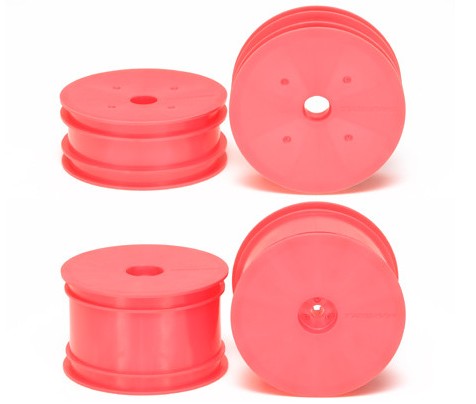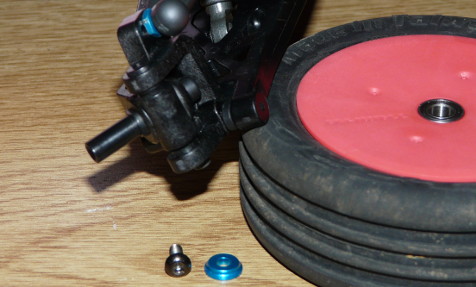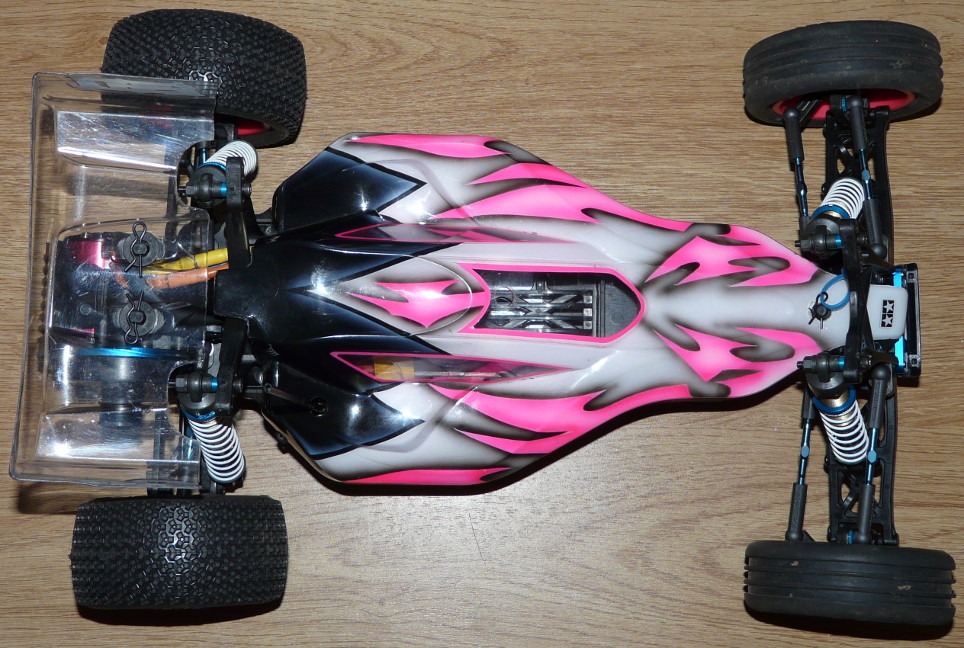TRF201 chassis: electronics
The next steps are about electronics and motor. It is a good time to lay your hand on that precision caliper: unlike some chassis, the TRF201 bathtub looks pretty spacious. Unfortunately, most of the available surface is condemned by the extremely low-profile bodyshell. Especially one component was tricky to install: the electronic speed controller. Indeed, even if these components are rather space-saving, most of them need a top fan to evacuate the heat. But this additional height becomes crucial whenever the bodyshell has such a low profile as the TRF201'. To be more precise, the (only) 35mm high of my HobbyKing ESC merely clear the highest section of the bodyshell. Merely, that is not counting the one-millimeter thick double sided-tape and not leaving room at all on top of the fan to evacuate the heat. In concrete, if your ESC is over 30mm high, it will dangerously be too close from the bodyshell to correctly evacuate the heat generated when it operates.
After many tries, I came up with an unusual yet functional solution:

As you can see, the ESC is lying on its side because I couldn't fit its 35mm high anywhere else under the bodyshell without at best the fan touching the bodyshell. In fact, this configuration is not a problem for the ESC to work correctly, but it is not the best to tape it to the chassis since the sides were not designed for this purpose.
Now, let's talk about the motor:



The first photo is just a detail, but it is a pleasant attention: this is a pass cable to transfer the ESC signal wire from one side of the chassis to the other where the receiver is located. A band of scotch tape will then cover the gap allowing battery manipulation with no risk to torture the wire.
As for the motor, nothing fancy. However, the motor guard looks like it was designed for brushed motors which cables are located at the rear end of the motor can. As brushless motors generally have cables oriented towards the motor axle, the motor guard leaves just enough room for them.
But about the motor, the most puzzling aspect is the motor pinion, and thus the spur gear: 48DP. Just like the vast majority of our planet, Tamiya uses the metric system on their models. This is the reason why buggies generally use 0.8 module motor pinions, on-road vehicles either 0.6 or 0.4. Just like ball bearings: the famous 1150 and 850, or even the 1050 mainly used on the TRF201 have metric dimensions.
However, the TRF201 48DP motor pinion and spur gear don't use the metric system but the archaic imperial system inherited from the British empire. Despite the entire world using the metric system, that even became the official universal system of measure, 3 countries, only 3 on the planet, still use the old imperial system. Believe it or not, we are not talking about the United Kingdom or any country from the Commonwealth (which would have made sense though): the objectors to the modern and universal system of measurement are the Liberia, Burma and... the USA!
If the influence of Liberia and Burma on RC is modest, not to say non-existent, major RC manufacturers such as Associated, Losi or Traxxas are american. Now, engineers working for these manufacturers still use the imperial system to design their models when the rest of the world industry (especially japanese) uses the metric system. Of course, both systems are incompatible, even though a few specific measures are very close (64DP and module 0.4 for example) and as such are considered by some people as compatible due to technical allowance. In fact, using a 64DP motor pinion with a module 0.4 spur gear (or the opposite), is a risk of premature wear (because technical allowance between the two is both ways: both closing the gap between the two and enlarging the gap). In the end, no measurement system is more efficient or better performing than the other: one model using a "pitch"-design will never go any "better" than a "module"-designed model, or reverse.
Several motor pinions: 48DP 25T, module 0.4 25T, module 0.6 25T and module 0.8 19T.

Wrongly, some people consider that the "pitch" is used by "racing" models whereas the "module" would be limited to "leisure" models. Serious mistake that lasts since the beginning of RC and which is somewhat country-specific. Historically, the first serious RC manufacturer is Kyosho, japanese company using the metric system: as per logic, their first models (1/8th GP) were using a module 1 transmission. When electric RC came, the module was reduced to 0.8 then 0.6 or 0.4 depending on the kind of model, both for a question of efficiency (the bigger the module, the greater the efficiency loss) and for a question of scale reduction (1/10th). As per logic too, Tamiya and all other japanese RC manufacturers used the metric system.
Later, american manufacturers came in, first Associated then Losi and Traxxas, and designed their models using the old imperial system. Not just to be awkward or for any performance reason, just because their engineers received a scholar eduction based upon the imperial system still used in their country. The urban legend saying "pitch for racing, module for leisure" came from the fact that Associated and Losi are manufacturers almost exclusively focused on racing, when Kyosho and Tamiya offer both racing and leisure-oriented ranges of products. As simple as that ![]()
Eventually, the pitch became a de facto standard in off-road 4x2 buggies due to Associated multiples world championship victories with their RC10. Kyosho, Tamiya and the other manufacturers made their models compatibles, but only the motor pinion and spur gear: all the design of off-road buggies from japanese manufacturers (among others) are still using the metric system, as the ball bearings used on the models prove.
By the way, you can notice that despite a similar hegemony from Tamiya in the DTM category with the TRF 4xx chassis since 2002, the metric 0.4 module did not become a de facto standard for american manufacturers. On the other hand, if all manufacturers had to change their measurement system after every world championship winner...
OK, after this informative break, let's get back to the TRF201 transmission for a second: as every transmission (at least off-road), it is protected by a cover preserving it from any exterior element that could cause damage to the gears. So it is on the TRF201, with a slight difference:

Well no, you're not dreaming: the gear cover lets the transmission "breathe" deeply. Despite everything adjusting to perfection throughout the chassis, the cover meant to protect the gears (spur gear, motor pinion and slipper) adjusts like... humm, hell? Definitely unworthy from a Tamiya production. I want to specify that the gear cover on my model has no defects (not bent): another gear cover carefully cut from the sprue shows the exact same symptom, which is also confirmed by several comments on different forums. It is hard to understand how Tamiya could let such a defect pass through, especially on a high-end model targeted to serious racing.
Anyway, the only solution I found is to use electrician tape to fill the hole. Home-made and definitely not reaching the standard of the model, but still, it does the job.
TRF201 chassis: tires
End of the chassis build by preparing the wheels: this is an important step especially with a racing buggy. As a friend of mine says "tires are 80% of the performance". Also meaning: "once the driver manages to keep his car on the track" ![]() .
.


The rims I chose come from the Zahhak, reference 54279 and 54280 because their color will perfectly suit the bodyshell. As you can see on the photo, the rear rims are specific, but shared with the DB-01 and TRF501X chassis: no hexa but only the axle that usually serve to drive the hexa. I think this system was first seen on the Associated RC10B3, but I still wonder what's the positive aspect of this solution compared to an hexa: apart from the weight (those few grams at the lowest point of the chassis?), I can't see any interest to this "innovation", that even Associated abandoned if I'm correct. Nevertheless, Tamiya uses it on a few chassis, thus the need for specific rims, also because the wheel axle of the universal driveshafts is bigger than usual. Usual hexa are not compatible and as a consequence, usual hexa-driven rims are not either.
As we speak about rims, let's talk about tires. Guess what? The terrific imperial system is back ![]() . Indeed, americans (I doubt Liberia and Burma could be charged for anything about that) imposed their system of measure on off-road tires too, thus tire dimensions are always specified in inches. So here we come again, tires and rims being involved this time. Anyway, note that for on-road tires and rims, the metric system rules. Gotcha!
. Indeed, americans (I doubt Liberia and Burma could be charged for anything about that) imposed their system of measure on off-road tires too, thus tire dimensions are always specified in inches. So here we come again, tires and rims being involved this time. Anyway, note that for on-road tires and rims, the metric system rules. Gotcha! ![]()
Anyway, apart from Tamiya (to my knowledge) that keeps on with metrics, all other RC manufacturers use 2.2 rims for buggies. Nevertheless, on relatively recent models, Tamiya introduced rims with an outer diameter measure that is very close from the 2.2 inches, which makes them compatible with every 2.2" tire. The only disadvantage is that you need to glue the tire on all its circumference to make sure it fits perfectly to the rim because there is a 2mm difference with the "true" 2.2 inches measure. You can find those "inch-compatible metric rims" on the DT-02 and DT-03 chassis, DF-03, DB-01 and DN-01. This, of course, only if you need other tires than those available from Tamiya, which is the case for me since our track at the club is very delicate in terms of grip.
However, to fit 2.2 inches rims on Tamiya buggies, you need to take care of a second crucial factor: bearings and wheel axles. Indeed, just like on the TRF201, the front wheels need 1050 metric ball bearings, which means metric-sized housings on the rims, but also metric-sized wheel axles (5mm, the inner diameter of bearings). As you could expect, the bearings used by manufacturers using the imperial system are not compatible, either with the rims or the wheel axles.
The TRF201 inaugurates a new type of front wheel axle:


On the left, what we were used to see for years (here on my Bear Hawk), the famous molded upright Tamiya introduced back in 1980 with the Holiday Buggy and Sand Rover. On the right, the modern version as first seen on the TRF201: same function, apart from the fact that the axle is now a threaded tube in which you place a screw to hold the wheel instead of blocking the wheel with a lock nut (the blue alloy spacer is something I added, it is not recommend in the manual). The big advantage here is that you can remove this metric-sized wheel axle to replace it with an imperial-sized one (reference 54220) that will be compatible with rims using 3/16" x 3/8" imperial-sized bearings (no joking!).
Come on, that's easy: three sixteenth of inch (0.1875 inch, that is 0.4763cm) by three eighth of inch (0.3750 inch, that is 0.9525cm). Yes, I can supply aspirin: free shipping for orders over 1kg ![]() .
.
The build of the TRF201 is now finished: time to install the bodyshell for an overview.


Building this chassis took me several hours of intense modeler's pleasure: parts adjusting with such precision and no play. I must confess, for example, that I spent several minutes playing with the steering system which precision and smoothness still amaze me. The TRF201 chassis is definitely a very complex design, and yet, pretty easy to build whatever the step. Besides, not being any kind of specialist of having made measurements with tools I don't have, the center of gravity looks and feels very low and most of the weight concentrates at the closest of the center line of the chassis. Even if I still haven't driven it at the time of writing this, the TRF201 gives me the impression that it should be quite impressive on high-grip tracks (carpet type).
Now let's see how it handles on the very technical track at the club... even if I already have an idea after I tested the chassis of my friend David from RC 4 Old Nuts ![]() .
.
First runs
My TRF201 mainly started spinning its wheels at a friendly race organized at the club. The day before, I just checked the build and the gear ratio, the slipper being the only parameter I had to adjust due to the very low grip conditions of our track.


The race day, my TRF201 was lining up with Associated RC10 B5s and other Losi 22s. Of course, the general handling of the buggy is very much comparable to the other pretenders, that is far better than what my Sand Viper was capable of. Suspension smoothness, steering precision and the overall stability whatever the circumstances are the main characteristics that outclass a leisure-oriented chassis like the DT-02. Of course, budget is not the same and these two chassis were not designed for the same use.
Besides, the slipper and the sensored brushless motor are probably the most influencing elements to provide smoothness and comfort in driving, especially on a very low grip track. The overall handling is much better, smoother and more precise, so driving is significantly different. In these conditions, driving the Sand Viper was mainly about fighting with the chassis in order to control the power and the chassis reactions on the track. With the TRF201, driving is all about controlling the lines as the reactions of the chassis on the track feel very natural.


Don't get me wrong: despite its technical limitations, driving the Sand Viper is both a pleasure and an excellent training. The TRF201 provides a much more natural and predictable handling on the track which allows you to focus your attention on the lines and the hunt for speed.
Surprisingly, despite the TRF201 sophistication, my results on the track were worse this time than in previous races when I was driving my Sand Viper. I noticed I was making many more driving faults than usual, probably because the TRF201 seems much easier to control so I drove with too much confidence, and probably also because the grip conditions of the track had never been that bad in previous races. Overall, I didn't feel "at ease" with my car compared to the Sand Viper: no doubt this is a question of training and getting used to the new car.


The dirt on top of the damper mounts is the proof that I definitely need to drive it, to do a lot of training to learn how to better control this buggy and to improve my driving skills. Saying that, even though a chassis is technically much better than another, in the end, the difference is always made with training and skills.
Related articles
- 58116 Dyna Storm
- 58374 Sand Viper - DT-02
- TamTech Gear Porsche 935 Martini (about the slipper clutch)




